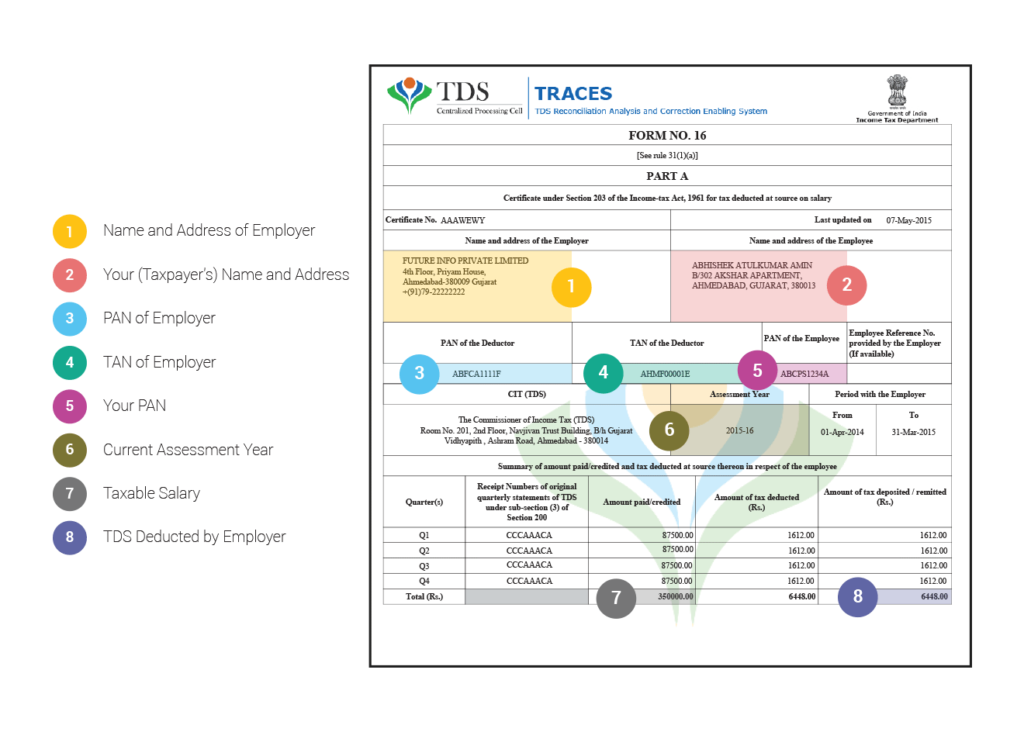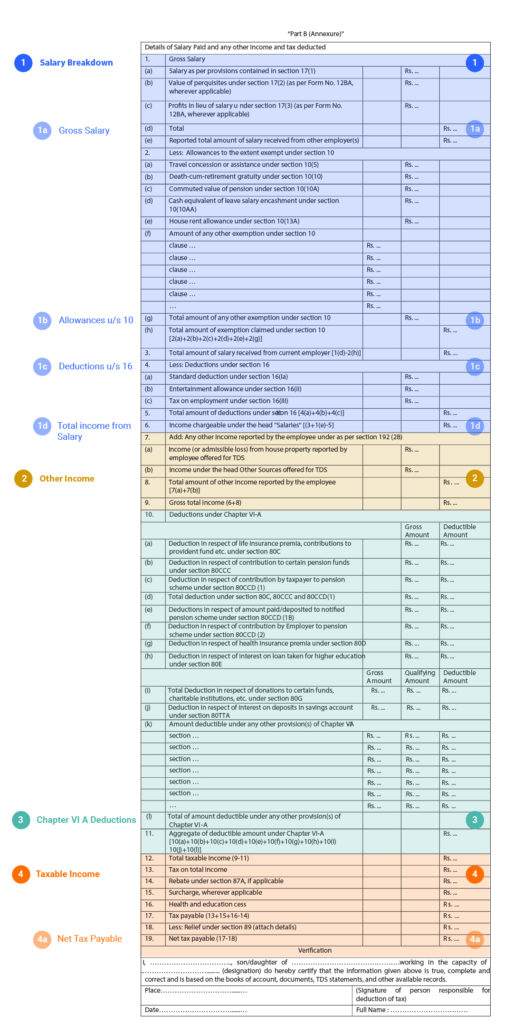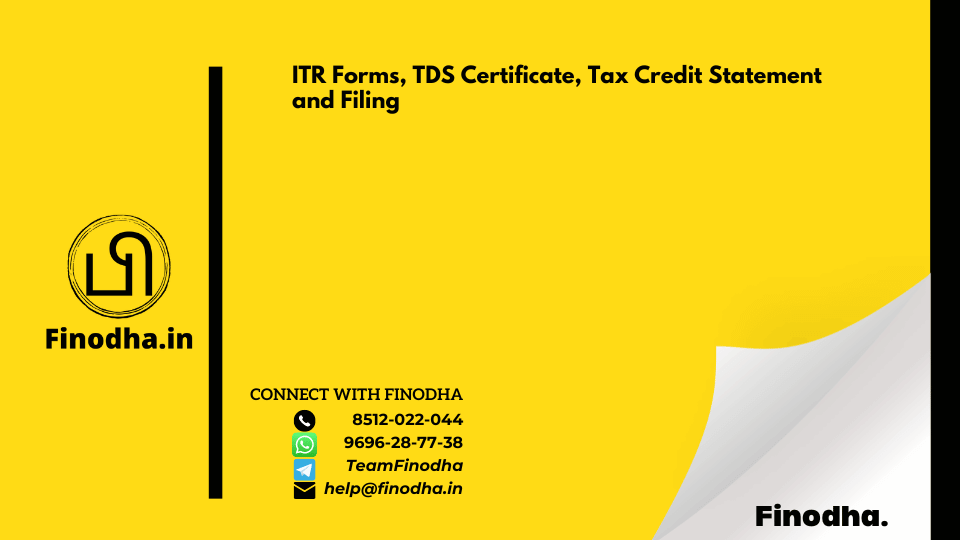Important Keyword: Form 26AS, ITR Forms, TDS Certificate.
Table of Contents
ITR Forms, TDS Certificate, Tax Credit Statement and Filing
The Income Tax Department has designed different types of ITR Forms to cater to different income scenarios. It’s important for taxpayers to determine which ITR Form is applicable to them for the specific financial year and file accordingly.
Each taxpayer must carefully prepare and submit the ITR Form that corresponds to their income situation. This ensures accurate reporting and compliance with tax regulations.
ITR Form Types
The Income Tax Department has provided seven distinct ITR Forms, each tailored to specific income situations. It’s crucial for taxpayers to select the appropriate ITR Form that aligns with their individual income circumstances. This ensures proper reporting and compliance with tax requirements.
ITR-1,
ITR-1, also known as SAHAJ, is designated for resident salaried individuals. This form is specifically designed for individuals earning income from the following sources:
- Salary
- Pension
- Income from one house property
- Other sources such as interest from savings, fixed deposits, etc.
- Agricultural income less than INR 5,000.
For filing ITR 1:
Documents required:
- Salary Income: Form 16 or Salary Slips
- Pension Income: Pension Statement/ Bank Statement
- House Property: Address proof, co-owner details, loan interest/repayment certificate, rental agreement
- Other Incomes: Passbook, interest certificates, dividend warrants/counterfoils, other receipts
Steps to file ITR 1 using Income Tax Website:
- Log in to your income tax e-filing account and navigate to e-File > Income Tax Return
- Select the Assessment Year, ITR Form, Submission Mode (Prepare and Submit ITR online)
- Choose the details you want prefilled from records available with the ITD
- Preview and recheck the prepared ITR
- Submit the ITR
- e-Verify the ITR
For filing ITR 3:
Documents required:
- Business & Professional income: Bank account Statement/ Passbook
- Capital Gains: Land/building Sales and Purchase Deed, Stock Ledgers, Trading Statement, expenses on transfer of capital asset, etc.
- House Property Income: Rent Agreement, co-owner details, Loan repayment certificate/statements.
- Salary: Form 16, Salary Slips, Pension Statement/Passbook
- Other Sources: Dividend warrants, interest certificates, other receipts
Methods to file ITR 3:
- Online submission: After adding Digital Signature or sending the signed copy for verification to CPC Bangalore
- Physical submission: Paper form or bar-code return form (for income less than INR 5 Lakhs, electronic filing is optional, but for income exceeding INR 5 Lakhs, electronic filing is mandatory).
ITR 4
ITR 4 is tailored for Individuals, HUFs, and Partnership Firms who have elected to use the presumptive taxation scheme under sections 44AD, 44ADA, or 44AE. Taxpayers in these categories with income from the following sources are eligible to file ITR 4:
- Businesses eligible for the presumptive taxation scheme
- Professionals and Freelancers eligible for the presumptive taxation scheme
- Salary/Pension
- One House Property (excluding cases with carried forward losses)
- Other Sources: Dividend warrants, interest certificates, and other receipts.
Taxpayers with income from capital gains, speculative business, or foreign sources are ineligible to file ITR 4.
Documents required to file ITR 4:
- Business/Professions: Profit & Loss Statement, Balance Sheet, Supporting documents for expenses, Cash Register, etc.
- Salary Income: Form 16, Salary Slips, Passbook, Pension Statement
- House Property: Rent Agreement, co-owner details, Loan repayment certificate/statements
- Other Sources: Dividend warrants, interest certificates, other receipts
Methods to file ITR 4:
- Physical Submission: Paper form or bar-code return form
- Online/Electronic Submission: After adding Digital Signature or sending the signed copy for verification to CPC Bangalore. However, it is mandatory to file ITR-4 online for taxpayers who:
- Have income exceeding INR 5 Lakh
- Possess assets outside of India or hold financial interest in any entity abroad or have signing authority in any foreign account
- Claim relief under sections 90/90A/91, requiring Schedule FSI and Schedule TR
Form 16:
Form 16 is a TDS certificate issued by employers to employees after the end of a financial year. It contains details of income earned and taxes deducted. Form 16 consists of two parts:
- Part A: Employer and employee details, along with TDS deducted by the employer
- Part B: Detailed breakdown of salary components under the head of ‘Salary’.
TDS Certificate: Sample Form 16 Part A

TDS Certificate: Sample Form 16 Part B

Form 16A, Form 26AS, Form 12BB, Form 10BA, Form 15G, and Form 15H are crucial documents related to income tax filings and TDS Certificate (Tax Deducted at Source). Let’s break down their roles and requirements:
- Form 16A: This TDS pertains to TDS on income other than salary, like commission, interest, or professional fees. It’s issued by the deductor (payer) to the deductee (payee) within 15 days from filing the TDS return.
- Form 26AS: A consolidated Tax Credit Statement, containing details like tax deducted from income, tax collected from payments, taxes paid (advance, self-assessment, regular assessment), tax refunds received, and high-value transactions. Taxpayers can set off tax credit against their net taxable liability while filing ITR. Form 26AS can be viewed and downloaded from the income tax e-filing website.
- Form 12BB: Employees submit this form to employers for accurate TDS deduction on salary. It includes details like House Rent Allowance (HRA), Leave Travel Allowance (LTA), interest deduction under “Income from House Property,” and Chapter VI-A deductions (u/s 80C – 80U).
- Form 10BA: Used to claim deduction u/s 80GG for rent paid on house property. It includes details of the taxpayer, property, rent paid, and the landlord. Form 10BA can be submitted for a financial year via the Income Tax Department website.
- Form 15G & Form 15H: These forms help taxpayers avoid TDS deduction on their income. Form 15H is for senior citizens, while Form 15G is for non-senior citizens. They are typically submitted at the beginning of the financial year to banks to avoid TDS on various income sources like EPF withdrawal, rent, interest income from fixed deposits, etc.
Details required for Form 15G or Form 15H include PAN, residential status, address, contact information, estimated income, and previously filed Form 15G/15H details. These forms can be filed physically or online with the deductor, such as banks, by downloading from the income tax website or through the deductor’s website.
Read More: Form 26AS: Tax Credit Statement
Web Stories: Form 26AS: Tax Credit Statement
Official Income Tax Return filing website: https://incometaxindia.gov.in/





0 Comments